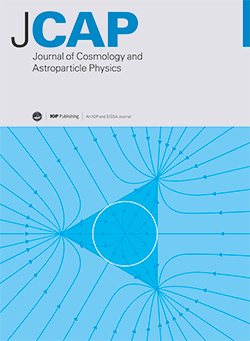Bounds on velocity-dependent dark matter-baryon scattering from large-scale structure
IF 5.3
2区 物理与天体物理
Q1 ASTRONOMY & ASTROPHYSICS
Journal of Cosmology and Astroparticle Physics
Pub Date : 2025-05-26
DOI:10.1088/1475-7516/2025/05/087
引用次数: 0
Abstract
We explore interacting dark matter (DM) models that allow DM and baryons to scatter off of each other with a cross section that scales with relative particle velocity. Using the effective field theory of large-scale structure, we perform the first analysis of BOSS full-shape galaxy clustering data for velocity-dependent DM-baryon interactions. We determine that while the addition of BOSS full-shape data visibly modifies the shape of the posterior distribution, it does not significantly alter the 95% confidence level intervals for the interaction cross section obtained from an analysis of the cosmic microwave (CMB) anisotropy from Planck measurements alone. Moreover, in agreement with previous findings, we note that the DM-baryon interacting model presents a good fit to both large-scale structure (LSS) data and CMB data and alleviates the S8 tension between the two data sets. After combining LSS and CMB data with weak lensing data from the Dark Energy Survey, we find a ≳ 2σ preference for non-zero interactions between DM and baryons in a velocity-independent model. We also explore a scenario where only a fraction of DM undergoes scattering with baryons; we find a similar ≳ 2σ preference for the presence of interactions. Our results suggest that a suppression of the linear matter power spectrum at small scales may be needed to resolve certain discrepancies between LSS and CMB data that are found in the cold DM (CDM) scenario.大尺度结构中速度依赖暗物质-重子散射的边界
我们探索相互作用的暗物质(DM)模型,该模型允许DM和重子相互散射,其横截面与相对粒子速度成比例。利用大尺度结构的有效场论,我们首次对速度依赖的dm -重子相互作用的BOSS全形状星系群集数据进行了分析。我们确定,虽然BOSS全形状数据的加入明显地改变了后验分布的形状,但它并没有显著改变从普朗克测量的宇宙微波(CMB)各向异性分析中获得的相互作用截面的95%置信区间。此外,与之前的研究结果一致,我们注意到dm -重子相互作用模型对LSS数据和CMB数据都有很好的拟合,并缓解了两个数据集之间的S8张力。将LSS和CMB数据与暗能量巡天的弱透镜数据结合起来,我们发现在一个速度无关的模型中,DM和重子之间的非零相互作用有一个< 2σ的偏好。我们还探索了一种情况,即只有一小部分DM被重子散射;我们发现对于相互作用的存在有类似的< 2σ >偏好。我们的研究结果表明,可能需要在小尺度上抑制线性物质功率谱,以解决冷DM (CDM)场景中LSS和CMB数据之间的某些差异。
本文章由计算机程序翻译,如有差异,请以英文原文为准。
求助全文
约1分钟内获得全文
求助全文
来源期刊

Journal of Cosmology and Astroparticle Physics
地学天文-天文与天体物理
CiteScore
10.20
自引率
23.40%
发文量
632
审稿时长
1 months
期刊介绍:
Journal of Cosmology and Astroparticle Physics (JCAP) encompasses theoretical, observational and experimental areas as well as computation and simulation. The journal covers the latest developments in the theory of all fundamental interactions and their cosmological implications (e.g. M-theory and cosmology, brane cosmology). JCAP''s coverage also includes topics such as formation, dynamics and clustering of galaxies, pre-galactic star formation, x-ray astronomy, radio astronomy, gravitational lensing, active galactic nuclei, intergalactic and interstellar matter.
 求助内容:
求助内容: 应助结果提醒方式:
应助结果提醒方式:


